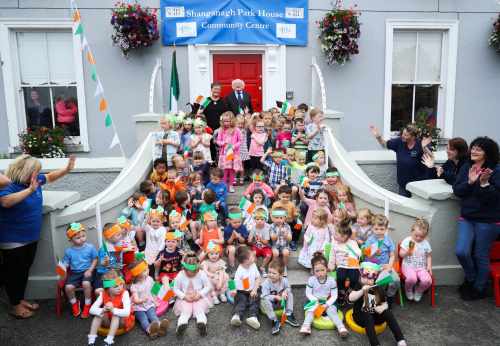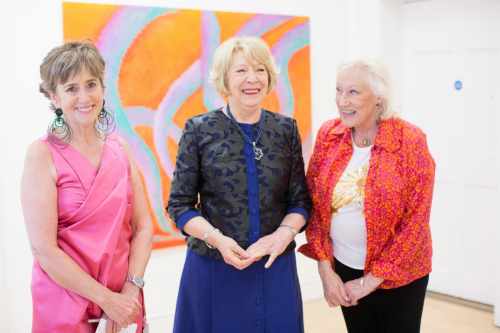Speech at the Celebration of the Bicentenary of Dún Laoghaire Harbour
King George IV Monument, Dún Laoghaire, 31 May 2017
Tá áthas orm bheith anseo i nDún Laoghaire inniu le bheith páirteach libh chun dhá chéad bliain de Chuan Dhún Laoghaire a cheiliúradh. Ba mhaith liom mo bhuíochas a ghabháil le Gerry Dunne, Príomhoifigeach Feidhmiúcháin agus le, Eithne Scott Lennon Cathaoirleach Chomhlacht Chuan Dhún Laoghaire, as a gcuireadh fial flaithiúil agus leis an gCathaoirleach an tUasal Cormac Devin as ucht na fáilte a chuir sé romham anseo inniu le feidhmiú ag an searmanas seo.
[I am delighted to be here in Dún Laoghaire today to join you in celebrating 200 years of Dún Laoghaire Harbour. May I thank Gerry Dunne, Chief Executive Officer of the Harbour Company and Eithne Scott Lennon, Chairperson for their kind invitation and An Cathaoirleach Mr Cormac Devin for welcoming me here today to officiate at this ceremony.]
Dún Laoghaire Harbour is a place deeply embedded into Irish history, and has played a profound role in the lives of generations of our people. Two hundred years ago, when the Lord Lieutenant of Ireland, Earl Whitworth laid its foundation stone it was envisaged that the harbour would principally be a refuge for ships from bad weather. On the night of 18-19 November 1807, two troopships, the Prince of Wales, and the Rochdale, which had departed from Dublin, were driven onto the rocks between Blackrock and Dún Laoghaire with the loss of over 400 lives. This disaster gave new impetus to an existing campaign for a harbour to be constructed near Dublin, and by 1816, the legislation was passed authorising the construction of what is now called the "West Pier".
Across those two centuries, the harbour has evolved, adapted and adjusted and is today very much a place of community, leisure and enjoyment, contributing greatly to the vibrancy and popularity of Dún Laoghaire.
Today is a joyful celebration of Dún Laoghaire Harbour and the significant role it has played, and continues to play, in the life of our nation and our people. Although this is a celebratory commemoration, let us not forget the workers who laboured over a period of approximately twenty-five years, in dangerous conditions, to construct this harbour. There was enormous complexity and risk involved in the blasting and moving the stone which was quarried in Dalkey, Glasthule and Dun Laoghaire, to construct the two fine granite piers we see today. Of the thousand or so workers who took part in that dangerous work, many lost limbs, their sight and even their lives.
So, let us today remember those workers, and reflect on the importance of promoting and achieving decent and dignified standards for human work, and of upholding the principles and legal instruments that we, today, are fortunate to have had bequeathed to us by generations of committed men and women who sought to establish the rights of workers.
Indeed, it is remarkable, as we stand here today, to remember the very different Ireland in which this Harbour was conceived and constructed, and the long and eventful journey our nation has travelled since the foundation stone for Dun Laoghaire Harbour was laid in 1817. Just as the harbour has witnessed the rise and fall of sea levels here in Dun Laoghaire across the years and decades and centuries, so too has it observed the tides of history in our constantly evolving nation.
The beginnings of this harbour are rooted in an Ireland under British rule, and an Ireland that in 1817 was experiencing a famine that was to claim 65,000 lives within two years. This tragedy, of course, was to be dwarfed thirty years later by the cataclysm of An Gorta Mór, the Great Famine, whose legacy is so deeply embedded in our national psyche.
Across the lifetime of the harbour the ever-changing tide of Ireland’s history has seen us undertake the long and difficult journey which would culminate in a newly independent State. It has seen us, along with the rest of Europe witness the devastation wrought by two World Wars. On the 10th of October 1918, shortly after leaving the harbour, the RMV Leinster was torpedoed by a German u-boat, bringing a taste of the carnage of the First World War close to home. Over 500 lives were lost off the Kish bank that day, 99 years ago.
The harbour has been witness to how our nation, once divided against itself, has made such significant progress towards full peace and reconciliation. And it has, of course, seen us become a vibrant and multi-cultural nation adapting to a greatly changing demographic.
Today, the life of the harbour and its surrounds continue to adapt and change as part of a modern Ireland that faces new and complex challenges in this global and interconnected age. Indeed, an important part of this bicentenary celebration will be the capturing of this contemporary moment through the placing in a few minutes of a time capsule beside the monument of King George IV, which has been here since 1823, I understand. The capsule will contain letters from local school children, photographs of the Harbour taken during this bicentenary year, messages from some of those who use the harbour, a copy of today’s newspaper and a letter from An Cathaoirleach.
All of these items, which speak of the everyday life of our citizens, form an important preservation of the present for a generation yet to come; a generation whose lives and society will be so much shaped by what has gone before. Just as we are all custodians of history, recipients of stories, anecdotes and accounts of the past, handed on to us by previous generations, so also we are recorders of the present moment which will craft what is yet to come. We do not yet know the full shape of the society that will exist when this time capsule is opened, but I have no doubt that its contents will provide interesting and informative reading for those who inhabit that society.
Dún Laoghaire Town and Harbour have undertaken their own interesting odyssey throughout the last two hundred years. The transfer of the mail boat service to Dún Laoghaire from Howth harbour in 1826 and the extension of the railway from Dublin city in 1834 to service it, transformed what was then a small fishing village into a suburban town of considerable scale and significance.
With the combined growth in efficiency and speed of both the railway and steam packet ships, the harbour became an important centre for travel between Ireland and Britain. Indeed, it became a point of departure for many of those who emigrated from Ireland and is etched into many individual family histories as a place of sad farewells and new beginnings of hope and optimism. Most of the emigrants who left through Dún Laoghaire landed at Liverpool, many settling there and in other parts of Britain, and many others finding further passage on ships going to America or Canada, their descendants now proud members of Ireland’s global family.
Today, of course, Dún Laoghaire Harbour is very much focussed on marine leisure activities and of course, the harbour is synonymous with sailing. While it no longer provides commercial port activity, the amenity value of the harbour continues to grow, as can be seen from the array of yachts and sail boats which are docked here.
Indeed, over the past number of years Dún Laoghaire has played host to some of the most prestigious European and World Sailing Championships and will, next year, host the World Laser Masters Championship - the first time this prestigious annual world championship will be sailed in Irish waters. It is indeed a testament to the sailing community in the harbour that it has produced such fine ambassadors for sailing, including more recently Annalise Murphy, our wonderful Olympic silver medallist.
Níl aon amhras ann faoi thábhacht leanúnach Chuan Dhún Laoghaire ná an cion leanúnach atá ag daoine air, ní amháín ag saoránaigh na háite féin ach ag an iomad daoine a thagann anseo chuile lá. Ba thógáil croí dom an deis a bheith agam teact anseo inniu agus an slua mór daoine a fheiceáil a bhailigh le chéile chun an comóradh tábhachtach seo a cheiliúradh. Is comhartha suntasach é sin de ról bunúsach Dhún Laoghaire san aonú haois is fiche.
[There can be no doubting the continued relevance of Dún Laoghaire Harbour, and the ongoing affection in which it is held, not only by local citizens but by the many people who visit here every day. It has been most uplifting to have the opportunity to come here today and witness the large crowd gathered to celebrate this important anniversary. That is a great testament to the integral role of Dún Laoghaire Harbour in 21st century Ireland.]
May I conclude by thanking all those individuals and organisations involved in the ongoing commemorations here in Dún Laoghaire. I would like to mention, in particular, all those who have worked tirelessly to organise the numerous events around the harbour and the town to celebrate this historic initiative, the bicentenary of the harbour. I would encourage everyone to get involved in the celebrations and to continue to enjoy and treasure this wonderful amenity.
Go raibh míle maith agaibh go léir.


